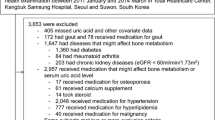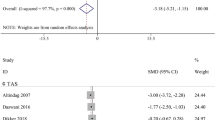Abstract
Background and aims: Mildly elevated homocysteine (Hcy) and oxidative stress are novel and potentially modifiable risk factors for post-menopausal osteoporosis. We hypothesized that imbalance of oxidant/antioxidant status and increased Hcy concentration stimulates osteoporotic activity, leading to increased collagen I breakdown in post-menopausal women. Methods: Patients were divided into 2 groups (NOP and OP). Group NOP had normal bone mineral density (BMD) and group OP low BMD. Thirty-four (69%) were in group OP and 15 (31%) in group NOP. Serum Total Antioxidant Status (TAS) and Total Peroxide (TPx) levels were determined with new automated methods. The study included measurement of Deoxypyridinoline (DPD). Results: In OP patients plasma t-Hcy, urine deoxypyridinoline and plasma TPx were significantly higher than those in NOP controls. In addition, OP patients also had lower TAS levels than controls, which represent the oxidative imbalance. Pearson’s correlation analysis revealed a negative correlation between t-Hcy and TAS (p<0.038). A significant negative correlation was also found between TAS level and BMD values for the spine in OP patients (p<0.035). In contrast, a positive correlation between t-Hcy and TPx in OP patients was demonstrated significantly, r=0.52, p<0.029. Conclusions: We show that the OP group had reduced TAS, whereas the elevated TPx was different from that in the NOP group. Slightly elevated homocysteinemia may contribute to increasing TPx and reducing TAS in the OP group. However, our results suggest a weak but negative relationship between TAS and BMD. Further investigations are needed to examine the relationship of oxidative stress as an endogenous bioactive agent to bone loss in post-menopausal women. Since oxidative stress is the imbalance between total oxidants and antioxidants in the body, any single oxidant/antioxidant parameter may not reflect overall oxidative stress. Further studies are needed to understand the underlying mechanisms of these findings.
Similar content being viewed by others
References
Cranney A, Jamal SA, Tsang JF, Josse RG, Leslie WD. Low bone mineral density and fracture burden in postmenopausal women. CMAJ 2007; 177: 575–80.
Herrmann M, Widmann T, Herrmann W. Homocysteine- a newly recognised risk factor for osteoporosis. Clin Chem Lab Med 2005; 43: 1111–7.
Yilmaz N, Kepkep N, Cicek HK et al. Relation of parity and homocysteine to bone mineral density of postmenopausal women. Clin Lab 2006; 52: 49–54.
Herrmann M, Kraenzlin M, Pape G, Sand-Hill M, Herrmann W. Relation between homocysteine and biochemical bone turnover markers and bone mineral density in peri- and post-menopausal women. Clin Chem Lab Med 2005; 43: 1118–23.
Lean JM, Davies JT, Fuller K et al. A crucial role for thiol antioxidants in estrogen-deficiency bone loss. J Clin Invest 2003; 112: 915–23.
Altindag O, Erel O, Soran N, Celik H, Selek S. Total oxidative/anti-oxidative status and relation to bone mineral density in osteoporosis. Rheumatol Int 2008; 28: 317–21.
Koh JM, Lee YS, Kim YS et al. Homocysteine enhances bone resorption by stimulation of osteoclast formation and activity through increased intracellular ROS generation. J Bone Miner Res 2006; 21: 1003–11.
Muthusami S, Ramachandran I, Muthusamy B, Vasudevan G, Prabhu V, Subramaniam. Ovariectomy induces oxidative stress and impairs bone antioxidant system in adult rats. Clin Chim Acta 2005; 360: 81–6.
Yilmaz N, Bayram M, Erbagci AB, Kilincer MS. Diagnostic value of biochemical markers of bone turnover and postmenopausal osteoporosis. Clin Chem Lab Med 1999; 37: 137–43.
Atmaca A, Gedlik O. Effects of alendronate and risedronate on bone mineral density and bone turnover markers in late postmenopausal women with osteoporosis. Adv Ther 2006; 23: 842–53.
Erel O. A novel automated method to measure total antioxidant response against potent free radical reactions. Clin Biochem 2004; 37: 112–9.
Erel O. A new automated colorimetric method for measuring total oxidant status. Clin Biochem 2005; 38: 1103–11.
Herrmann M, Widmann T, Colaianni G, Colucci S, Zallone A, Herrmann W. Increased osteoclast activity in the presence of increased homocysteine concentrations. Clin Chem 2005; 51: 2348–53.
Kim DJ, Koh JM, Lee O. Homocysteine enhances apoptosis in human bone marrow stromal cells. Bone 2006; 39: 582–90.
Krumdieck CL, Prince CW. Mechanisms of homocysteine toxicity on connective tissues: implications for the morbidity of aging. J Nutr 2000; 130: 365S–8.
Lean JM, Jagger CJ, Kirstein B, Fuller K, Chambers TJ. Hydrogen peroxide is essential for estrogen-deficiency bone loss and osteoclast formation. Endocrinology 2005; 146: 728–35.
Abdelfatah A, Ducloux D, Toubin G, Motte G, Alber D, Chalopin JM. Treatment of hyperhomocysteinemia with folic acid reduces oxidative stress in renal transplant recipients. Transplantation 2002; 73: 663–5.
Alvares Delfino VD, de Andrade Vianna AC, Mocelin AJ, Barbosa DS, Mise RA, Matsuo T. Folic acid therapy reduces plasma homocysteine levels and improves plasma antioxidant capacity in hemodialysis patients. Nutrition 2007; 23: 242–7.
Hill CH, Mecham R, Starcher B. Fibrillin-2 defects impair elastic fiber assembly in a homocysteinemic chick model. J Nutr 2002; 132: 2143–50.
Majors AK, Pyeritz RE. A deficiency of cysteine impairs fibrillin-1 deposition: implications for the pathogenesis of cystathionine β-synthase deficiency. Mol Genet Metab 2000; 70: 252–60.
Kim HJ, Chang EJ, Kim HM et al. Antioxidant alpha-lipoic acid inhibits osteoclast differentiation by reducing nuclear factor-kappaB DNA binding and prevents in vivo bone resorption induced by receptor activator of nuclear factor-kappaB ligand and tumor necrosis factor-alpha. Free Radic Biol Med 2006; 40: 1483–93.
Saito M, Fujii K, Marumo K. Degree of mineralization-related collagen crosslinking in the femoral neck cancellous bone in cases of hip fracture and controls. Calcif Tissue Int 2006; 79: 160–8.
McLean RR, Jacques PF, Selhub J et al. Homocysteine as a predictive factor for hip fracture in older persons. N Engl J Med 2004; 350: 2042–9.
van Meurs JB, Dhonukshe-Rutten RA, Pluijm SM et al. Homocysteine levels and the risk of osteoporotic fracture. N Engl J Med 2004; 350: 2033–41.
Dhonukshe-Rutten RA, Pluijm SM, de Groot LC, Lips P, Smit JH, van Staveren WA. Homocysteine and vitamin B12 status relate to bone turnover markers, broadband ultrasound attenuation, and fractures in healthy elderly people. J Bone Miner Res 2005; 20: 921–9.
Tucker KL, Hannan MT, Qiao N et al. Low plasma vitamin B12 is associated with lower BMD: the Framingham Osteoporosis Study. J Bone Miner Res 2005; 20: 152–8.
Dhonukshe-Rutten RA, van Dusseldorp M, Schneede J, de Groot LC, van Staveren WA. Low bone mineral density and bone mineral content are associated with low cobalamin status in adolescents. Eur J Nutr 2005; 44: 341–6.
Teitelbaum SL. Bone resorption by osteoclasts. Science 2000; 289: 1504–8.
Maggio D, Barabani M, Pierandrei M. Marked decrease in plasma antioxidants in aged osteoporotic women: results of a cross-sectional study, J Clin Endocrinol Metab 2003; 88: 1523–7.
Oh B, Kim SY, Kim DJ et al. Associations of catalase gene polymorphisms with bone mineral density and bone turnover markers in postmenopausal women. J Med Genet 2007; 44: 62.
Bednarek-Tupikowska G, Bohdanowicz-Pawlak A, Bidzinska B, Milewicz A, Antonowicz-Juchniewicz J, Andrzejak R. Serum lipid peroxide levels and erythrocyte glutathione peroxidase and superoxide dismutase activity in premenopausal and postmenopausal women. Gynecol Endocrinol 2001; 15: 298–303.
Ozgocmen S, Kaya H, Fadillioglu E, Yilmaz Z. Effects of calcitonin, risedronate, and raloxifene on erythrocyte antioxidant enzyme activity, lipid peroxidation, and nitric oxide in postmenopausal osteoporosis. Arch Med Res 2007; 38: 196–205.
Rao LG, Mackinnon ES, Josse RG, Murray TM, Strauss A, Rao AV. Lycopene consumption decreases oxidative stress and bone resorption markers in postmenopausal women. Osteoporos Int. 2007; 18: 109–15.
Pasco JA, Henry MJ, Wilkinson LK, Nicholson GC, Schneider HG, Kotowicz MA. Antioxidant vitamin supplements and markers of bone turnover in a community sample of nonsmoking women. J Womens Health (Larchmt) 2006; 15: 295–300.
Sheweita SA, Khoshhal KI. Calcium metabolism and oxidative stress in bone fractures: role of antioxidants. Curr Drug Metab 2007; 8: 519–25.
Author information
Authors and Affiliations
Corresponding author
Rights and permissions
About this article
Cite this article
Yılmaz, N., Eren, E. Homocysteine oxidative stress and relation to bone mineral density in post-menopausal osteoporosis. Aging Clin Exp Res 21, 353–357 (2009). https://doi.org/10.1007/BF03324927
Received:
Accepted:
Published:
Issue Date:
DOI: https://doi.org/10.1007/BF03324927




